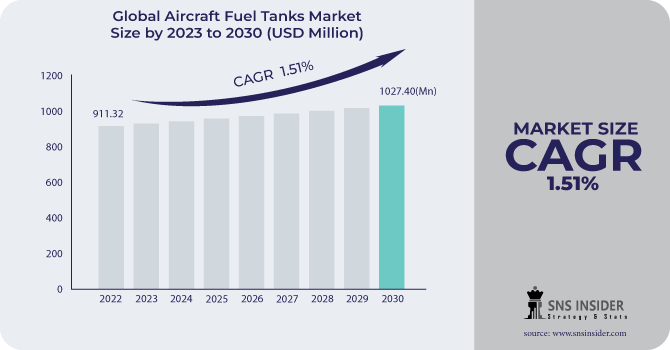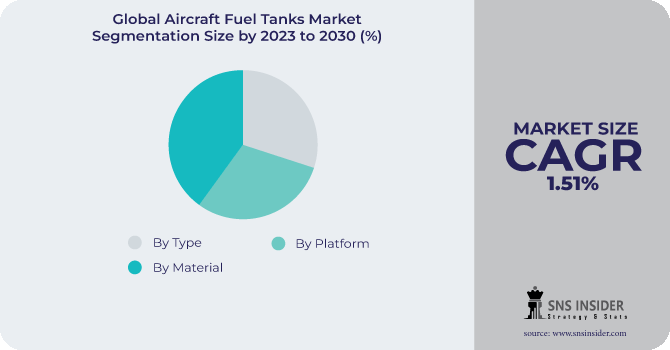Aircraft Fuel Tanks Market Report Scope & Overview:
The Aircraft Fuel Tanks Market size was valued at USD 911.32 Million & is estimated to reach USD 1027.40 Million by 2030 and increase at a compound annual growth rate of 1.51% between 2023 and 2030. Aircraft fuel tanks are integral components of aircraft, responsible for storing and supplying fuel to the engines. These tanks are designed to withstand the extreme conditions of flight, including high pressures, temperature fluctuations, and G-forces. The global aircraft fuel tanks market is driven by factors such as the increasing demand for new aircraft, the growth of the commercial aviation industry, and the need for more fuel-efficient aircraft. UAVs, commonly known as drones, are rapidly gaining traction across various industries, including military surveillance, commercial photography, agricultural inspections, and package delivery. These UAVs require regular maintenance and repair, which is driving the demand for Aircraft Fuel Tanks. The Aircraft Fuel Tanks market can be segmented by type, solution, deployment type, function, pricing model, and region.

To get more information on KEYWORD Market - Request Free Sample Report
On-premises Aircraft Fuel Tanks is expected to hold the largest share of the market in 2023, followed by cloud-based Aircraft Fuel Tanks. Enterprise Aircraft Fuel Tanks is expected to hold the largest share of the market in 2023, followed by mid-market and small-business Aircraft Fuel Tanks. Cloud-based Aircraft Fuel Tanks is expected to grow at the fastest CAGR during the forecast period.
Maintenance management is expected to hold the largest share of the market in 2023, followed by operations management and business management. Subscription-based pricing is expected to hold the largest share of the market in 2023, followed by perpetual licensing and pay-per-use pricing. North America is expected to be the largest market for Aircraft Fuel Tanks in 2023, followed by Europe and Asia Pacific. The Aircraft Fuel Tanks market is expected to grow at a healthy rate in the coming years. This growth is being driven by the increasing demand for new aircraft, the rise in air travel, and the growing popularity of UAVs. Players in the market are well-positioned to benefit from this growth by developing new and innovative Aircraft Fuel Tanks solutions, expanding into new markets, forming strategic partnerships, and investing in research and development.
MARKET DYNAMICS
DRIVERS:
-
Increasing Demand for New Aircraft.
The global aviation industry is expanding at a steady pace, driven by factors such as rising disposable incomes, expanding low-cost carrier operations, and growing demand for air travel in developing economies. This growth translates into a higher demand for new aircraft, which in turn necessitates robust and reliable aircraft fuel tanks to ensure their safe and efficient operation.
-
Rising Air Traffic Density.
The number of air passengers is projected to increase significantly, reaching an estimated. This surge in air traffic puts immense pressure on airspace management and navigation systems, leading to a demand for more sophisticated aircraft fuel tanks that can meet the stringent safety and regulatory requirements of the aviation industry.
RESTRAIN:
-
High Cost of Fuel Tanks.
The development and manufacturing of advanced aircraft fuel tanks involve substantial investments in research, design, and production. This translates into a higher cost for the equipment, which may limit its adoption by smaller aviation operators or those in developing economies.
-
Complexity of Integration with Existing Aircraft Systems.
Integrating new aircraft fuel tanks into existing aircraft avionics and fuel management systems can be a complex and time-consuming process. This complexity may hinder the adoption of new technologies, especially in legacy aircraft fleets.
OPPORTUNITY:
-
Growing Demand for Self-Service Fueling Solutions.
Airlines and maintenance providers are increasingly seeking self-service fueling solutions to streamline their operations and reduce downtime. This presents an opportunity for manufacturers to develop user-friendly and autonomous fuel tank systems that can be operated by technicians without extensive training.
-
Adoption of Predictive Maintenance Strategies.
Predictive maintenance strategies, which involve monitoring equipment condition data to anticipate potential failures, are gaining traction in the aviation industry. This opens up opportunities for the development of fuel tanks that can collect and analyze real-time data on fuel leakage, pressure, and temperature, enabling predictive maintenance practices.
CHALLENGES:
-
Integration with Emerging Technologies.
Integrating aircraft fuel tanks with emerging technologies such as the Internet of Things (IoT) and artificial intelligence (AI) can pose technical challenges. Manufacturers need to develop expertise in these technologies to ensure seamless integration and maximize the benefits of these advancements.
-
Addressing the Increasing Complexity of Fuel Management Systems.
Modern aircraft fuel systems are becoming increasingly complex, with multiple tanks, pumps, and sensors. This complexity requires more sophisticated fuel tanks that can adapt to the changing requirements and ensure efficient fuel management.
IMPACT OF RUSSIA-UKRAINE WAR
The ongoing Russia-Ukraine war has had a significant impact on the global economy, including the aviation industry and the MRO (Maintenance, Repair, and Overhaul) software market. The war has caused disruptions to the supply chain, increased costs, and created uncertainty in the market. The International Air Transport Association (IATA) expects air travel to decline by 5.5% in 2022. A recent survey of Aircraft Fuel Tanks providers found that 70% of respondents expect the war to have a negative impact on their business. Airlines are cutting back on flights and reducing their capacity. MRO providers are reporting a decrease in orders. The cost of Aircraft Fuel Tanks is increasing.
the ongoing Russia-Ukraine war is likely to have a negative impact on the aircraft fuel tanks market. The war is expected to lead to a decrease in air travel, which will in turn reduce the demand for aircraft fuel tanks. Additionally, the war is likely to make it more difficult for airlines and aircraft fuel tank manufacturers to finance new projects.
IMPACT OF ONGOING RECESSION
The ongoing recession is likely to have a mixed impact on the Aircraft Fuel Tanks market. While some airlines and MRO providers may delay or reduce their investments in new software solutions due to budget constraints, others may see Aircraft Fuel Tanks as an opportunity to improve efficiency and reduce costs during a challenging economic period. Airlines are cutting back on flights and reducing their capacity. This could lead to reduced maintenance needs and a corresponding decrease in demand for Aircraft Fuel Tanks.
The ongoing recession is likely to have a significant impact on the Aircraft Fuel Tanks Market. The recession is expected to lead to a decrease in air travel, which will in turn reduce the demand for Flight Management System (FMS). Additionally, the recession is likely to make it more difficult for airlines and airports to finance new Flight Management System (FMS) projects. The International Air Transport Association (IATA) expects air travel to decline by 5.5% in 2022. A recent survey of Flight Management System (FMS) manufacturers found that 68% of respondents expect the recession to hurt their business.
KEY MARKET SEGMENTATION
By Type
-
External
-
Internal
By Platform
-
Commercial Aviation
-
Military Aviation
By Material
-
Metallic Alloys
-
Carbon-based Composites
-
Polymers
-
Hybrid

Need any customization research on KEYWORD Market - Enquiry Now
REGIONAL COVERAGE:
North America
-
US
-
Canada
-
Mexico
Europe
-
Eastern Europe
-
Poland
-
Romania
-
Hungary
-
Turkey
-
Rest of Eastern Europe
-
-
Western Europe
-
Germany
-
France
-
UK
-
Italy
-
Spain
-
Netherlands
-
Switzerland
-
Austria
-
Rest of Western Europe
-
Asia Pacific
-
China
-
India
-
Japan
-
South Korea
-
Vietnam
-
Singapore
-
Australia
-
Rest of Asia Pacific
Middle East & Africa
-
Middle East
-
UAE
-
Egypt
-
Saudi Arabia
-
Qatar
-
Rest of Middle East
-
-
Africa
-
Nigeria
-
South Africa
-
Rest of Africa
-
Latin America
-
Brazil
-
Argentina
-
Colombia
-
Rest of Latin America
REGIONAL ANALYSIS
North America: North America is the largest market for FNSs due to the presence of major aircraft manufacturers such as Boeing and Bombardier, as well as the high demand for air travel in the region. The United States is the largest market in North America, followed by Canada and Mexico.
Asia Pacific: Asia Pacific is the fastest-growing market for FNSs due to the rapid growth of the aviation industry in the region. China is the largest market in the Asia Pacific, followed by India and Japan.
KEY PLAYERS
The Major Players are Meggitt PLC, Safran SA, GKN Aerospace (Melrose Industries), Cobham PLC, Robertson Fuel Systems LLC, Triumph Group, Inc., UTC Aerospace Systems, Honeywell International Inc, GE Aviation, AAR Corp and other players
Meggitt PLC-Company Financial Analysis

RECENT DEVELOPMENT
In 2023: The integration of Artificial Intelligence (AI) and Machine Learning (ML) AI and ML are being integrated into FMSs to enhance their capabilities in areas such as route optimization, weather avoidance, and predictive maintenance. These technologies enable FMSs to analyze vast amounts of data and make intelligent decisions in real time, leading to more efficient and safer navigation.
In 2022: Development of Autonomous Navigation Systems Autonomous navigation systems are being developed to reduce pilot workload and improve operational efficiency. These systems can autonomously plan and execute flight paths, taking into account factors such as weather, traffic, and airspace restrictions.
| Report Attributes | Details |
| Market Size in 2022 | US$ 911.32 Million |
| Market Size by 2030 | US$ 1027.40 Million |
| CAGR | CAGR of 1.51% From 2023 to 2030 |
| Base Year | 2022 |
| Forecast Period | 2023-2030 |
| Historical Data | 2019-2021 |
| Report Scope & Coverage | Market Size, Segments Analysis, Competitive Landscape, Regional Analysis, DROC & SWOT Analysis, Forecast Outlook |
| Key Segments | • By Type (External, Internal) • By Platform (Commercial Aviation, Military Aviation) • By Material (Metallic Alloys, Carbon-based Composites, Polymers, Hybrid) |
| Regional Analysis/Coverage | North America (US, Canada, Mexico), Europe (Eastern Europe [Poland, Romania, Hungary, Turkey, Rest of Eastern Europe] Western Europe] Germany, France, UK, Italy, Spain, Netherlands, Switzerland, Austria, Rest of Western Europe]), Asia Pacific (China, India, Japan, South Korea, Vietnam, Singapore, Australia, Rest of Asia Pacific), Middle East & Africa (Middle East [UAE, Egypt, Saudi Arabia, Qatar, Rest of Middle East], Africa [Nigeria, South Africa, Rest of Africa], Latin America (Brazil, Argentina, Colombia, Rest of Latin America) |
| Company Profiles | Meggitt PLC, Safran SA, GKN Aerospace (Melrose Industries), Cobham PLC, Robertson Fuel Systems LLC, Triumph Group, Inc., UTC Aerospace Systems, Honeywell International Inc, GE Aviation, AAR Corp |
| Key Drivers | • Increasing Demand for New Aircraft. • Rising Air Traffic Density. |
| Market Restrain | • High Cost of Fuel Tanks. • Complexity of Integration with Existing Aircraft Systems. |

